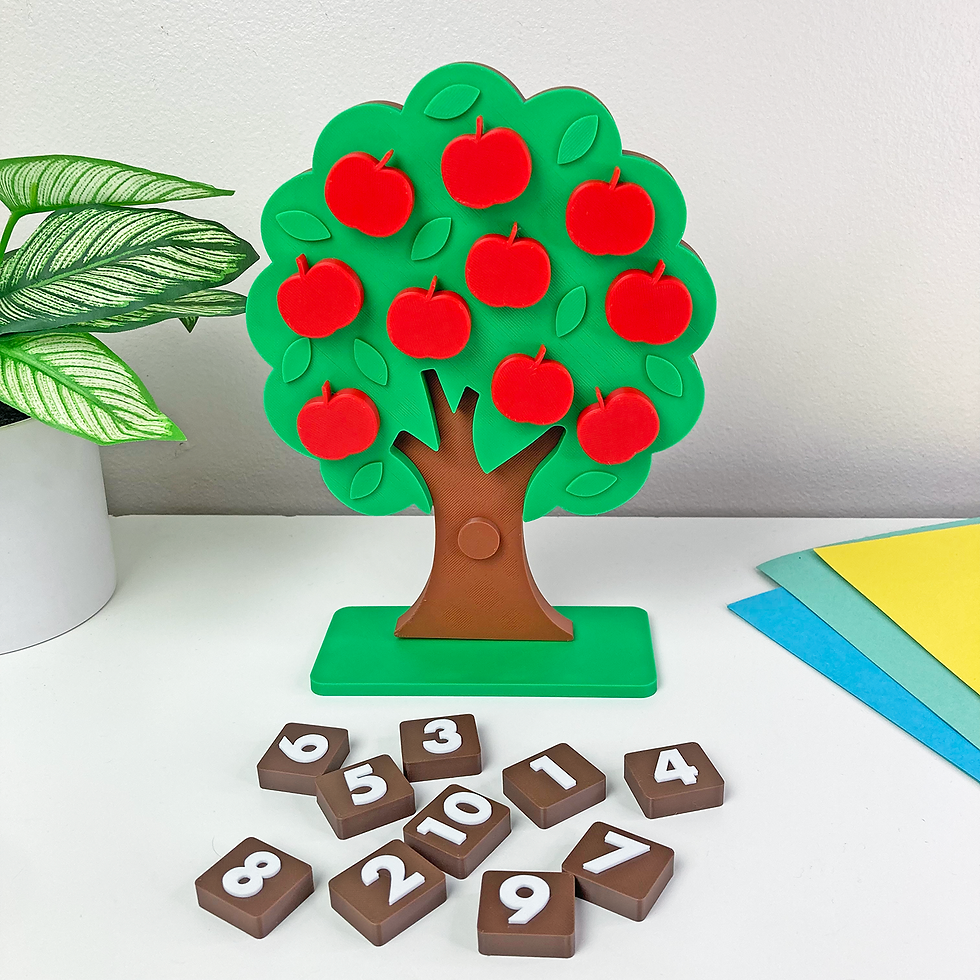🌸 Flower Cross Section 3D Model – A Hands-On Learning Tool for Kids
- Fun House Toys

- Jun 27
- 5 min read
Updated: Aug 23
Looking for a fun and educational way to teach kids about flowers? Our Flower Parts Cross Section Model is the perfect hands-on science tool for classrooms, homeschools, or nature-loving families. Designed to help children visually understand the anatomy of a flower, this 3D model is engaging, easy to use, and full of learning opportunities!
Whether you’re doing a spring science unit, planning a botany lesson, or simply want to explore how plant reproduction works, this STEM activity brings biology to life in a tangible, interactive way.

A Sustainable Learning Experience
Unlike our previous printable crafts, this model is part of our new Science Craft Collection. It is made from sustainable, non-toxic PLA material. These models are durable, display-ready, and perfect for homeschool, classroom settings, or weekend science fun at home.
And yes—while this version is a ready-to-go physical product available in our shop, we still include a free black-and-white worksheet version at the end of this post. This allows your little learners to color, cut, and label on paper too!
ADVERTISMENT
We have a shortlist of favorite science crafts like Layers of Atmosphere, Inner Earth Layers, Anatomy of a Volcano, and Layer of the Ocean. This activity is sure to become a new favorite. It comes together fast and is packed with educational insight.

🌼 What Is the Flower Cross Section Model?
This unique 3D flower model shows a cross-sectional view of a flower—meaning kids can see inside the flower and identify each part from the petals to the pistil. It’s designed like a puzzle that kids can build and display. Each anatomical piece clicks into place to form a complete model that stands upright using the included base.
Made from biodegradable, non-toxic PLA right here in the USA, it’s safe for kids and better for the planet. Plus, it comes with a free black-and-white worksheet you can print and color for extended learning!
It’s great for:
Visual learners who love building and seeing how things fit together.
Kids studying Botany, Flowers, or Science.
Homeschoolers and teachers needing hands-on activities for science units.
Gifted kids who enjoy tactile puzzles with an educational twist.

🧠 What Kids Will Learn
This model covers the main parts of a flower that are typically taught in early elementary and upper grades:
Petals
Stamens (Anther + Filament)
Pistil (Stigma, Style, Ovary, Ovules)
Sepals
Reproductive process of flowering plants
It’s perfect for 1st–5th grade, and it’s also a great visual aid for older learners studying plant biology.
ADVERTISMENT
✂️ How to Build the Flower Cross Section – Step-by-Step
Materials included:
3D printed flower model pieces
Display base
Instruction sheet
You’ll need:
Your hands and a flat surface
Optional: worksheet and crayons/markers for extended learning
Instructions:
1. Lay out all the pieces – Start by placing all flower parts in front of you. Identify each part using the info sheet.
2. Start from the bottom – Begin with the green sepal/base piece. This supports the entire flower.
3. Add the ovary and ovules sticker – attach the ovary sticker into place above the sepal. The swirl design inside shows the future seeds.
ADVERTISMENT
Attach the style and stigma – Stack the style on top of the ovary, then press the sticky stigma into place at the top.
Insert the stamens – Slide the filament pieces (the yellow stems) around the pistil. Then press the anthers onto the ends.
Add the petals – Snap the red petals around the center to complete the flower.
Place it on the stand – Once all pieces are securely in place, attach the flower to the base for an upright display.
💡 Tip: Press pieces gently but firmly. If you ever want to remove parts, pull gently.
ADVERTISMENT
💡 Fun Facts About Flowers – WOW Your Kids!
🌼 The world’s largest flower, Rafflesia arnoldii, can grow over 3 feet wide and smells like rotting meat to attract flies!
🦋 Flowers like the passionflower have ten or more floral parts—way more complex than most!
🐝 Sunflowers are actually made up of thousands of tiny flowers arranged in a spiral! What we see as one flower is a whole community.
🎨 Some flowers change color to tell pollinators they’ve already been visited—nature’s way of saying, “I’m closed for business!”

💡 Tips for Parents and Teachers
🌸 Make it interactive:Turn learning into a fun game! Ask your child questions like:➡️ “Which part of the flower is like a mailbox and catches the pollen?” (Answer: Stigma)➡️ “Which part turns into seeds after pollination?” (Answer: Ovary and ovules)
🧵 Incorporate storytelling:As your child assembles the flower, weave a fun story:🌼 “Imagine a bee flying in for a snack. It brushes past the anthers, collects pollen, and lands on the sticky stigma of another flower. The adventure begins!”This narrative helps reinforce how pollination works in a memorable way.
📚 Connect it to real flowers:After building the model, go outside and find real flowers. Help your child identify the parts on a daisy, lily, or tulip. Ask: “Can you find the sepals on this flower?” or “Where do you think the ovary is hiding?”
🎨 Reinforce through creativity:Encourage your child to draw their own flower, label the parts, or even invent a “new” flower species with silly parts and imaginative functions!
🪴 Keep it on display:Place the finished cross section on a bookshelf or science station. Visuals encourage curiosity! Children love showing off what they've made and often revisit topics when models stay in view.
🔄 Extend the lesson:Use this model to kick off a mini-unit on plant life cycles, seed dispersal, or pollinators. Pair it with a simple seed planting activity so they can observe how flowers grow from the ground up!

ADVERTISMENT
💬 Questions to Ask Your Child While Exploring the Flower Model
Keep your child engaged by turning this activity into a fun conversation! Ask open-ended questions to spark curiosity and help them think critically about what they’re building.
Try these while assembling the flower:
🌸 “What do you think the petals are for?”(Hint: They attract bees and butterflies!)
🌿 “Can you find the part where the seeds grow?”(Look inside the ovary!)
🐝 “Why do you think flowers need pollen?”(Talk about how plants make seeds!)
🔍 “Which part do you think is the most important?”(Let them choose and explain why!)
🧠 “Do all flowers look the same?”(Encourage them to look at real flowers in your yard or local park!)
🌱 “What happens to a flower after it’s pollinated?”(Lead into a lesson about fruits and seeds!)
ADVERTISMENT
Try These Science Crafts
All of these crafts can be made with no prep to make your activity planning even easier!
Layers of Atmosphere - Layers of the Earth Space
Inner Earth Layers - Layers of the Earth Inner Core
Anatomy of a Volcano - Let's Make A Volcano that is Fun & Educational
Milky Way Spiral - Journey through our Galaxy
♻️ Built for the Planet and Built to Last
📦 Where to Get Your Flower Parts Model
Our Flower Cross Section Puzzle is available in our shop and ships quickly from our family-run studio in Georgia. Each piece is hand-drawn and 3D printed in small batches with eco-friendly PLA material.
✅ Made in the USA
✅ Safe and Non-Toxic for Kids
✅ Reusable and Durable for Classrooms
✅ Includes Display Stand & Bonus Printable Worksheet
📦 Click below to shop the Flower Cross Section Model and start your science learning journey today!
Not ready to commit to the 3D version just yet? We’ve got you covered! Click on the printer icon to download a FREE black-and-white worksheet version of the Brain Puzzle. It’s perfect for coloring, cutting, and reviewing anatomy through paper-based fun.
Loved this printable?
Join our community on social media and be the first to discover exciting new activities, exclusive freebies, and limited-time discounts. Follow us and let’s make learning even more fun and creative together!
ADVERTISMENT


























